Analysis of Intercultural Communication in the U.S. Military
VerifiedAdded on 2020/10/22
|8
|2477
|260
Report
AI Summary
This report provides an in-depth analysis of intercultural communication within the U.S. Military. It begins with an introduction to intercultural communication and then focuses on the U.S. Military culture, examining its language (including ESP, jargon, and informal speech), folktales, values (patriotism, cohesion, humanitarian services, ethical duty), and non-verbal communication styles. The report explores the role of government and education in shaping military culture, as well as the healthcare and business aspects. It then delves into stereotypes and prejudices about the military, comparing and contrasting military values with societal values. The report addresses preconceived ideas that were found to be inaccurate and suggests steps for effective communication within the military workplace. Furthermore, it discusses the problem of abusive communication and gender bias, highlighting the use of informal language and gender stereotypes. The conclusion summarizes the key findings of the report.
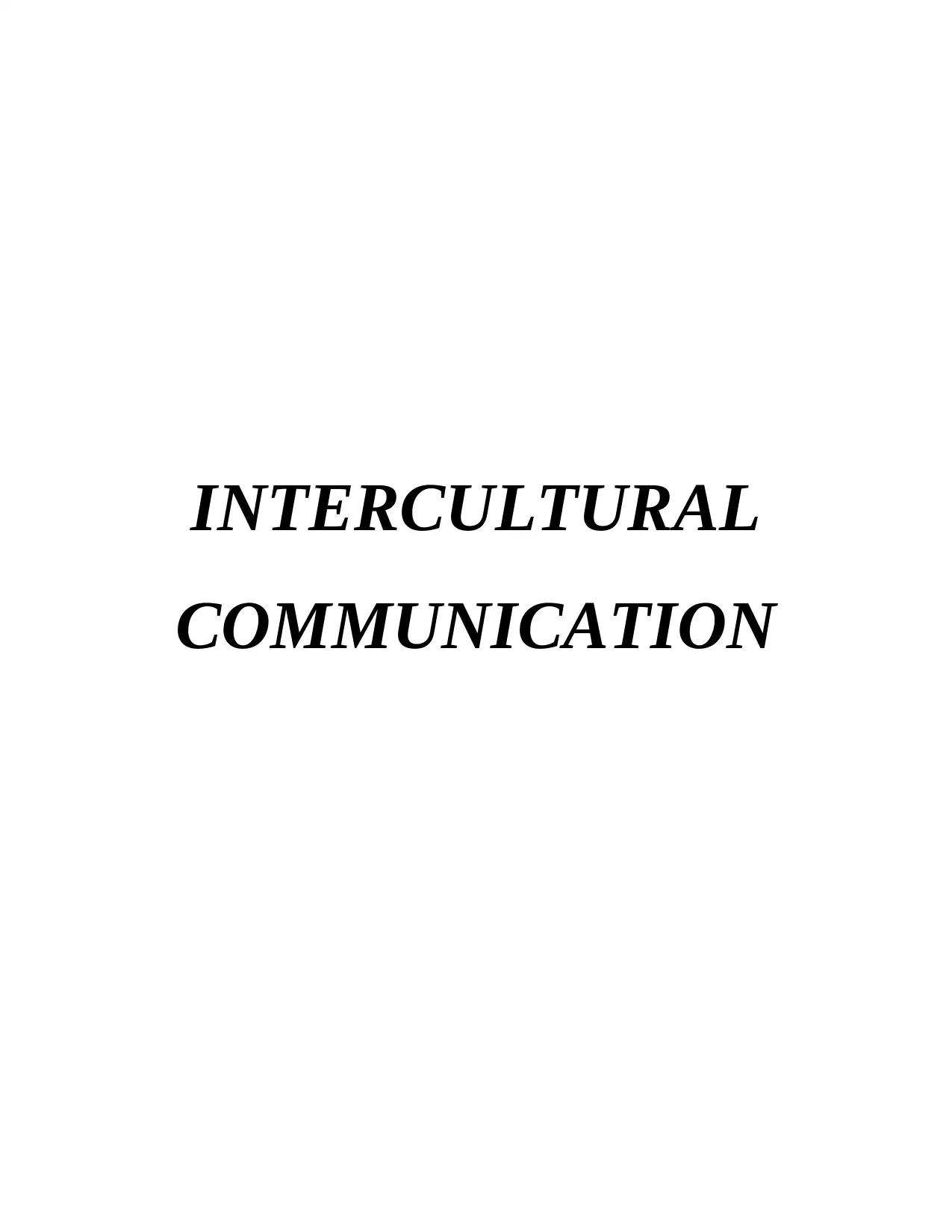
INTERCULTURAL
COMMUNICATION
COMMUNICATION
Paraphrase This Document
Need a fresh take? Get an instant paraphrase of this document with our AI Paraphraser
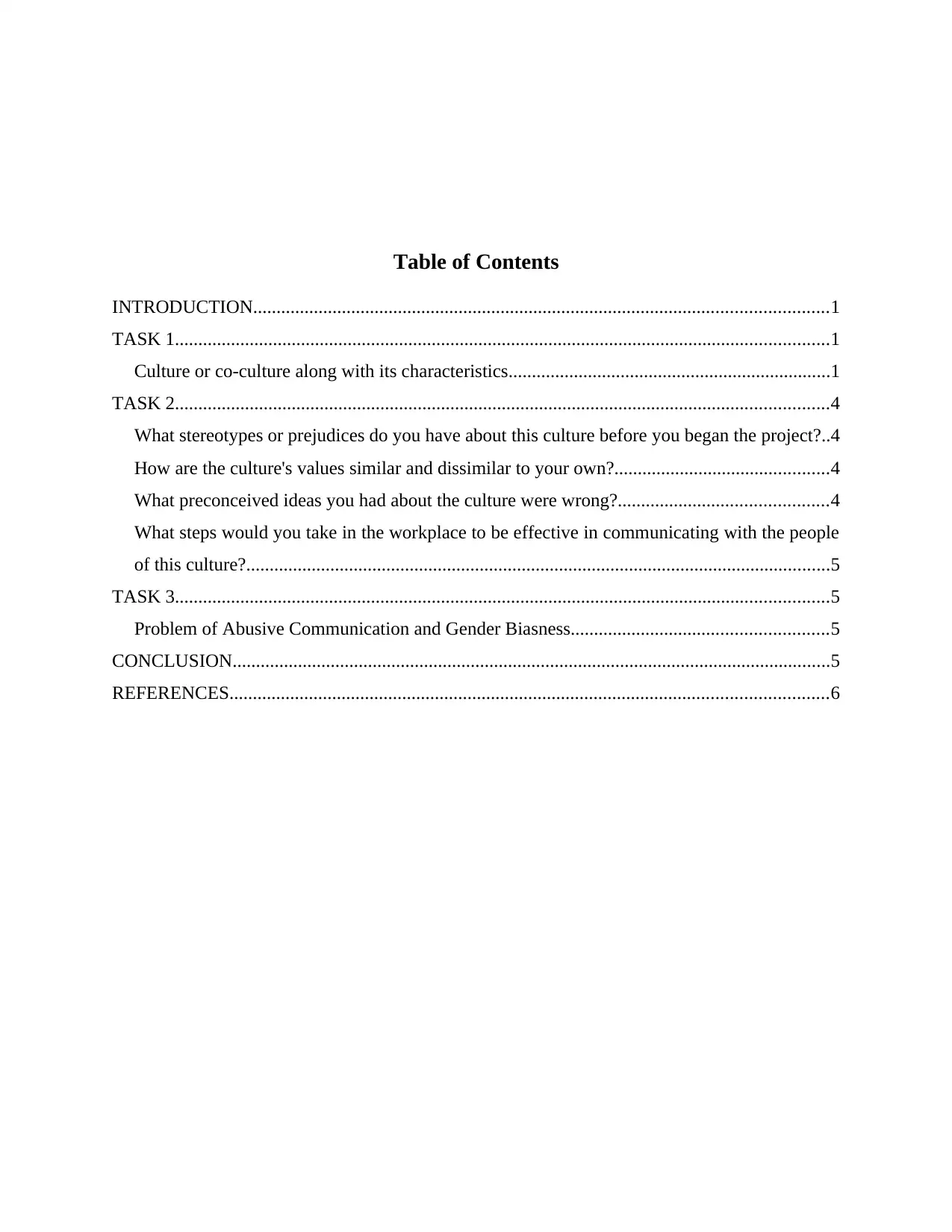
Table of Contents
INTRODUCTION...........................................................................................................................1
TASK 1............................................................................................................................................1
Culture or co-culture along with its characteristics.....................................................................1
TASK 2............................................................................................................................................4
What stereotypes or prejudices do you have about this culture before you began the project?..4
How are the culture's values similar and dissimilar to your own?..............................................4
What preconceived ideas you had about the culture were wrong?.............................................4
What steps would you take in the workplace to be effective in communicating with the people
of this culture?.............................................................................................................................5
TASK 3............................................................................................................................................5
Problem of Abusive Communication and Gender Biasness.......................................................5
CONCLUSION................................................................................................................................5
REFERENCES................................................................................................................................6
INTRODUCTION...........................................................................................................................1
TASK 1............................................................................................................................................1
Culture or co-culture along with its characteristics.....................................................................1
TASK 2............................................................................................................................................4
What stereotypes or prejudices do you have about this culture before you began the project?..4
How are the culture's values similar and dissimilar to your own?..............................................4
What preconceived ideas you had about the culture were wrong?.............................................4
What steps would you take in the workplace to be effective in communicating with the people
of this culture?.............................................................................................................................5
TASK 3............................................................................................................................................5
Problem of Abusive Communication and Gender Biasness.......................................................5
CONCLUSION................................................................................................................................5
REFERENCES................................................................................................................................6
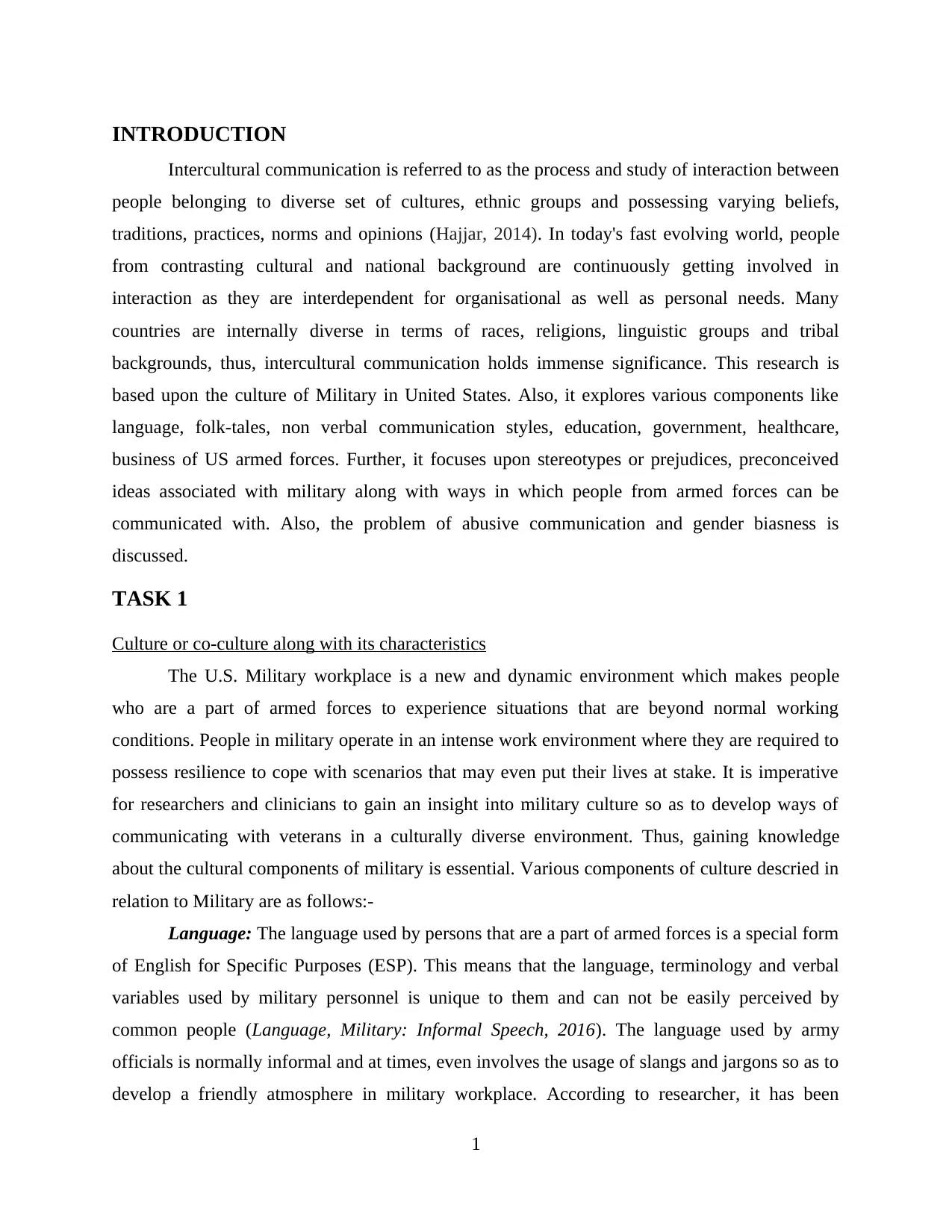
INTRODUCTION
Intercultural communication is referred to as the process and study of interaction between
people belonging to diverse set of cultures, ethnic groups and possessing varying beliefs,
traditions, practices, norms and opinions (Hajjar, 2014). In today's fast evolving world, people
from contrasting cultural and national background are continuously getting involved in
interaction as they are interdependent for organisational as well as personal needs. Many
countries are internally diverse in terms of races, religions, linguistic groups and tribal
backgrounds, thus, intercultural communication holds immense significance. This research is
based upon the culture of Military in United States. Also, it explores various components like
language, folk-tales, non verbal communication styles, education, government, healthcare,
business of US armed forces. Further, it focuses upon stereotypes or prejudices, preconceived
ideas associated with military along with ways in which people from armed forces can be
communicated with. Also, the problem of abusive communication and gender biasness is
discussed.
TASK 1
Culture or co-culture along with its characteristics
The U.S. Military workplace is a new and dynamic environment which makes people
who are a part of armed forces to experience situations that are beyond normal working
conditions. People in military operate in an intense work environment where they are required to
possess resilience to cope with scenarios that may even put their lives at stake. It is imperative
for researchers and clinicians to gain an insight into military culture so as to develop ways of
communicating with veterans in a culturally diverse environment. Thus, gaining knowledge
about the cultural components of military is essential. Various components of culture descried in
relation to Military are as follows:-
Language: The language used by persons that are a part of armed forces is a special form
of English for Specific Purposes (ESP). This means that the language, terminology and verbal
variables used by military personnel is unique to them and can not be easily perceived by
common people (Language, Military: Informal Speech, 2016). The language used by army
officials is normally informal and at times, even involves the usage of slangs and jargons so as to
develop a friendly atmosphere in military workplace. According to researcher, it has been
1
Intercultural communication is referred to as the process and study of interaction between
people belonging to diverse set of cultures, ethnic groups and possessing varying beliefs,
traditions, practices, norms and opinions (Hajjar, 2014). In today's fast evolving world, people
from contrasting cultural and national background are continuously getting involved in
interaction as they are interdependent for organisational as well as personal needs. Many
countries are internally diverse in terms of races, religions, linguistic groups and tribal
backgrounds, thus, intercultural communication holds immense significance. This research is
based upon the culture of Military in United States. Also, it explores various components like
language, folk-tales, non verbal communication styles, education, government, healthcare,
business of US armed forces. Further, it focuses upon stereotypes or prejudices, preconceived
ideas associated with military along with ways in which people from armed forces can be
communicated with. Also, the problem of abusive communication and gender biasness is
discussed.
TASK 1
Culture or co-culture along with its characteristics
The U.S. Military workplace is a new and dynamic environment which makes people
who are a part of armed forces to experience situations that are beyond normal working
conditions. People in military operate in an intense work environment where they are required to
possess resilience to cope with scenarios that may even put their lives at stake. It is imperative
for researchers and clinicians to gain an insight into military culture so as to develop ways of
communicating with veterans in a culturally diverse environment. Thus, gaining knowledge
about the cultural components of military is essential. Various components of culture descried in
relation to Military are as follows:-
Language: The language used by persons that are a part of armed forces is a special form
of English for Specific Purposes (ESP). This means that the language, terminology and verbal
variables used by military personnel is unique to them and can not be easily perceived by
common people (Language, Military: Informal Speech, 2016). The language used by army
officials is normally informal and at times, even involves the usage of slangs and jargons so as to
develop a friendly atmosphere in military workplace. According to researcher, it has been
1
⊘ This is a preview!⊘
Do you want full access?
Subscribe today to unlock all pages.

Trusted by 1+ million students worldwide
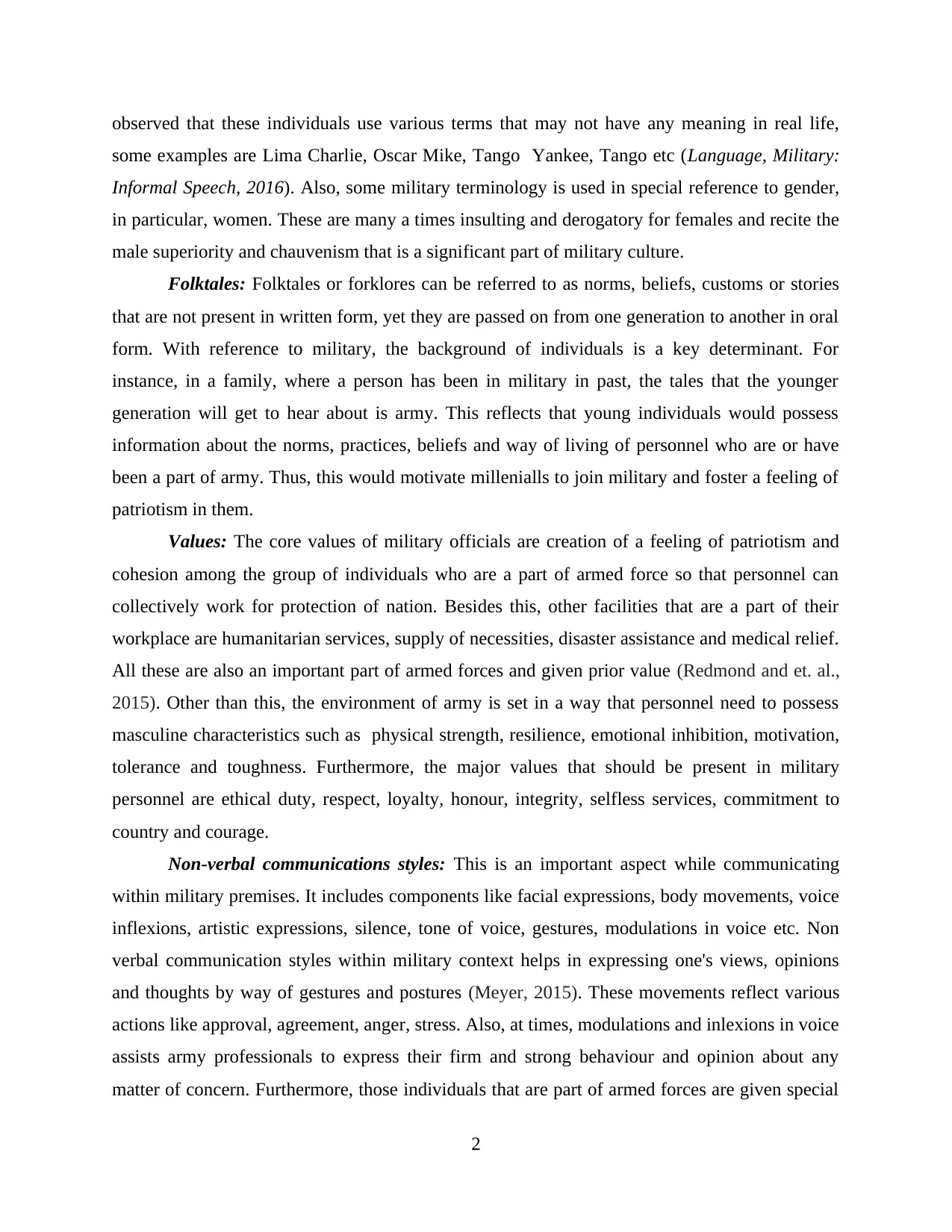
observed that these individuals use various terms that may not have any meaning in real life,
some examples are Lima Charlie, Oscar Mike, Tango Yankee, Tango etc (Language, Military:
Informal Speech, 2016). Also, some military terminology is used in special reference to gender,
in particular, women. These are many a times insulting and derogatory for females and recite the
male superiority and chauvenism that is a significant part of military culture.
Folktales: Folktales or forklores can be referred to as norms, beliefs, customs or stories
that are not present in written form, yet they are passed on from one generation to another in oral
form. With reference to military, the background of individuals is a key determinant. For
instance, in a family, where a person has been in military in past, the tales that the younger
generation will get to hear about is army. This reflects that young individuals would possess
information about the norms, practices, beliefs and way of living of personnel who are or have
been a part of army. Thus, this would motivate millenialls to join military and foster a feeling of
patriotism in them.
Values: The core values of military officials are creation of a feeling of patriotism and
cohesion among the group of individuals who are a part of armed force so that personnel can
collectively work for protection of nation. Besides this, other facilities that are a part of their
workplace are humanitarian services, supply of necessities, disaster assistance and medical relief.
All these are also an important part of armed forces and given prior value (Redmond and et. al.,
2015). Other than this, the environment of army is set in a way that personnel need to possess
masculine characteristics such as physical strength, resilience, emotional inhibition, motivation,
tolerance and toughness. Furthermore, the major values that should be present in military
personnel are ethical duty, respect, loyalty, honour, integrity, selfless services, commitment to
country and courage.
Non-verbal communications styles: This is an important aspect while communicating
within military premises. It includes components like facial expressions, body movements, voice
inflexions, artistic expressions, silence, tone of voice, gestures, modulations in voice etc. Non
verbal communication styles within military context helps in expressing one's views, opinions
and thoughts by way of gestures and postures (Meyer, 2015). These movements reflect various
actions like approval, agreement, anger, stress. Also, at times, modulations and inlexions in voice
assists army professionals to express their firm and strong behaviour and opinion about any
matter of concern. Furthermore, those individuals that are part of armed forces are given special
2
some examples are Lima Charlie, Oscar Mike, Tango Yankee, Tango etc (Language, Military:
Informal Speech, 2016). Also, some military terminology is used in special reference to gender,
in particular, women. These are many a times insulting and derogatory for females and recite the
male superiority and chauvenism that is a significant part of military culture.
Folktales: Folktales or forklores can be referred to as norms, beliefs, customs or stories
that are not present in written form, yet they are passed on from one generation to another in oral
form. With reference to military, the background of individuals is a key determinant. For
instance, in a family, where a person has been in military in past, the tales that the younger
generation will get to hear about is army. This reflects that young individuals would possess
information about the norms, practices, beliefs and way of living of personnel who are or have
been a part of army. Thus, this would motivate millenialls to join military and foster a feeling of
patriotism in them.
Values: The core values of military officials are creation of a feeling of patriotism and
cohesion among the group of individuals who are a part of armed force so that personnel can
collectively work for protection of nation. Besides this, other facilities that are a part of their
workplace are humanitarian services, supply of necessities, disaster assistance and medical relief.
All these are also an important part of armed forces and given prior value (Redmond and et. al.,
2015). Other than this, the environment of army is set in a way that personnel need to possess
masculine characteristics such as physical strength, resilience, emotional inhibition, motivation,
tolerance and toughness. Furthermore, the major values that should be present in military
personnel are ethical duty, respect, loyalty, honour, integrity, selfless services, commitment to
country and courage.
Non-verbal communications styles: This is an important aspect while communicating
within military premises. It includes components like facial expressions, body movements, voice
inflexions, artistic expressions, silence, tone of voice, gestures, modulations in voice etc. Non
verbal communication styles within military context helps in expressing one's views, opinions
and thoughts by way of gestures and postures (Meyer, 2015). These movements reflect various
actions like approval, agreement, anger, stress. Also, at times, modulations and inlexions in voice
assists army professionals to express their firm and strong behaviour and opinion about any
matter of concern. Furthermore, those individuals that are part of armed forces are given special
2
Paraphrase This Document
Need a fresh take? Get an instant paraphrase of this document with our AI Paraphraser
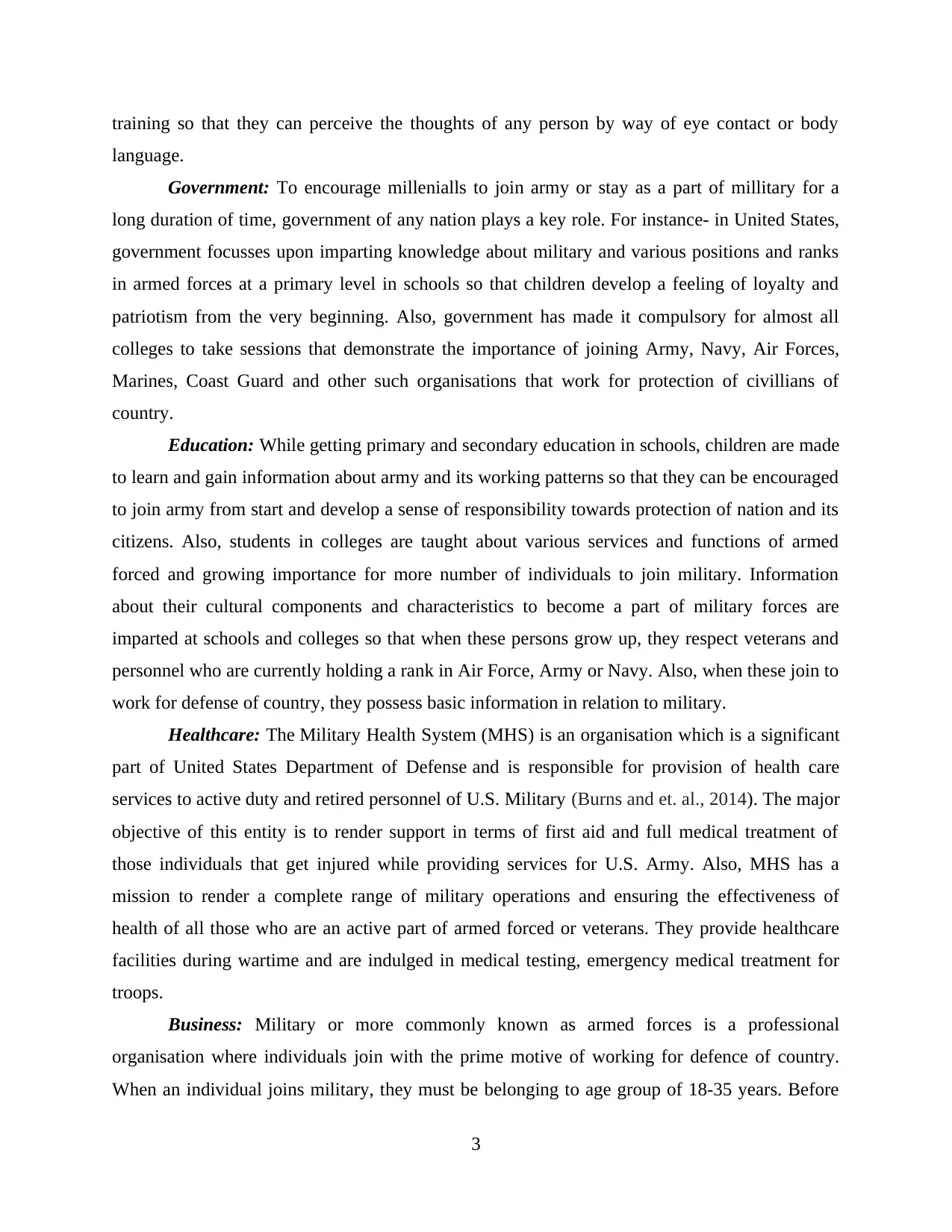
training so that they can perceive the thoughts of any person by way of eye contact or body
language.
Government: To encourage millenialls to join army or stay as a part of millitary for a
long duration of time, government of any nation plays a key role. For instance- in United States,
government focusses upon imparting knowledge about military and various positions and ranks
in armed forces at a primary level in schools so that children develop a feeling of loyalty and
patriotism from the very beginning. Also, government has made it compulsory for almost all
colleges to take sessions that demonstrate the importance of joining Army, Navy, Air Forces,
Marines, Coast Guard and other such organisations that work for protection of civillians of
country.
Education: While getting primary and secondary education in schools, children are made
to learn and gain information about army and its working patterns so that they can be encouraged
to join army from start and develop a sense of responsibility towards protection of nation and its
citizens. Also, students in colleges are taught about various services and functions of armed
forced and growing importance for more number of individuals to join military. Information
about their cultural components and characteristics to become a part of military forces are
imparted at schools and colleges so that when these persons grow up, they respect veterans and
personnel who are currently holding a rank in Air Force, Army or Navy. Also, when these join to
work for defense of country, they possess basic information in relation to military.
Healthcare: The Military Health System (MHS) is an organisation which is a significant
part of United States Department of Defense and is responsible for provision of health care
services to active duty and retired personnel of U.S. Military (Burns and et. al., 2014). The major
objective of this entity is to render support in terms of first aid and full medical treatment of
those individuals that get injured while providing services for U.S. Army. Also, MHS has a
mission to render a complete range of military operations and ensuring the effectiveness of
health of all those who are an active part of armed forced or veterans. They provide healthcare
facilities during wartime and are indulged in medical testing, emergency medical treatment for
troops.
Business: Military or more commonly known as armed forces is a professional
organisation where individuals join with the prime motive of working for defence of country.
When an individual joins military, they must be belonging to age group of 18-35 years. Before
3
language.
Government: To encourage millenialls to join army or stay as a part of millitary for a
long duration of time, government of any nation plays a key role. For instance- in United States,
government focusses upon imparting knowledge about military and various positions and ranks
in armed forces at a primary level in schools so that children develop a feeling of loyalty and
patriotism from the very beginning. Also, government has made it compulsory for almost all
colleges to take sessions that demonstrate the importance of joining Army, Navy, Air Forces,
Marines, Coast Guard and other such organisations that work for protection of civillians of
country.
Education: While getting primary and secondary education in schools, children are made
to learn and gain information about army and its working patterns so that they can be encouraged
to join army from start and develop a sense of responsibility towards protection of nation and its
citizens. Also, students in colleges are taught about various services and functions of armed
forced and growing importance for more number of individuals to join military. Information
about their cultural components and characteristics to become a part of military forces are
imparted at schools and colleges so that when these persons grow up, they respect veterans and
personnel who are currently holding a rank in Air Force, Army or Navy. Also, when these join to
work for defense of country, they possess basic information in relation to military.
Healthcare: The Military Health System (MHS) is an organisation which is a significant
part of United States Department of Defense and is responsible for provision of health care
services to active duty and retired personnel of U.S. Military (Burns and et. al., 2014). The major
objective of this entity is to render support in terms of first aid and full medical treatment of
those individuals that get injured while providing services for U.S. Army. Also, MHS has a
mission to render a complete range of military operations and ensuring the effectiveness of
health of all those who are an active part of armed forced or veterans. They provide healthcare
facilities during wartime and are indulged in medical testing, emergency medical treatment for
troops.
Business: Military or more commonly known as armed forces is a professional
organisation where individuals join with the prime motive of working for defence of country.
When an individual joins military, they must be belonging to age group of 18-35 years. Before
3
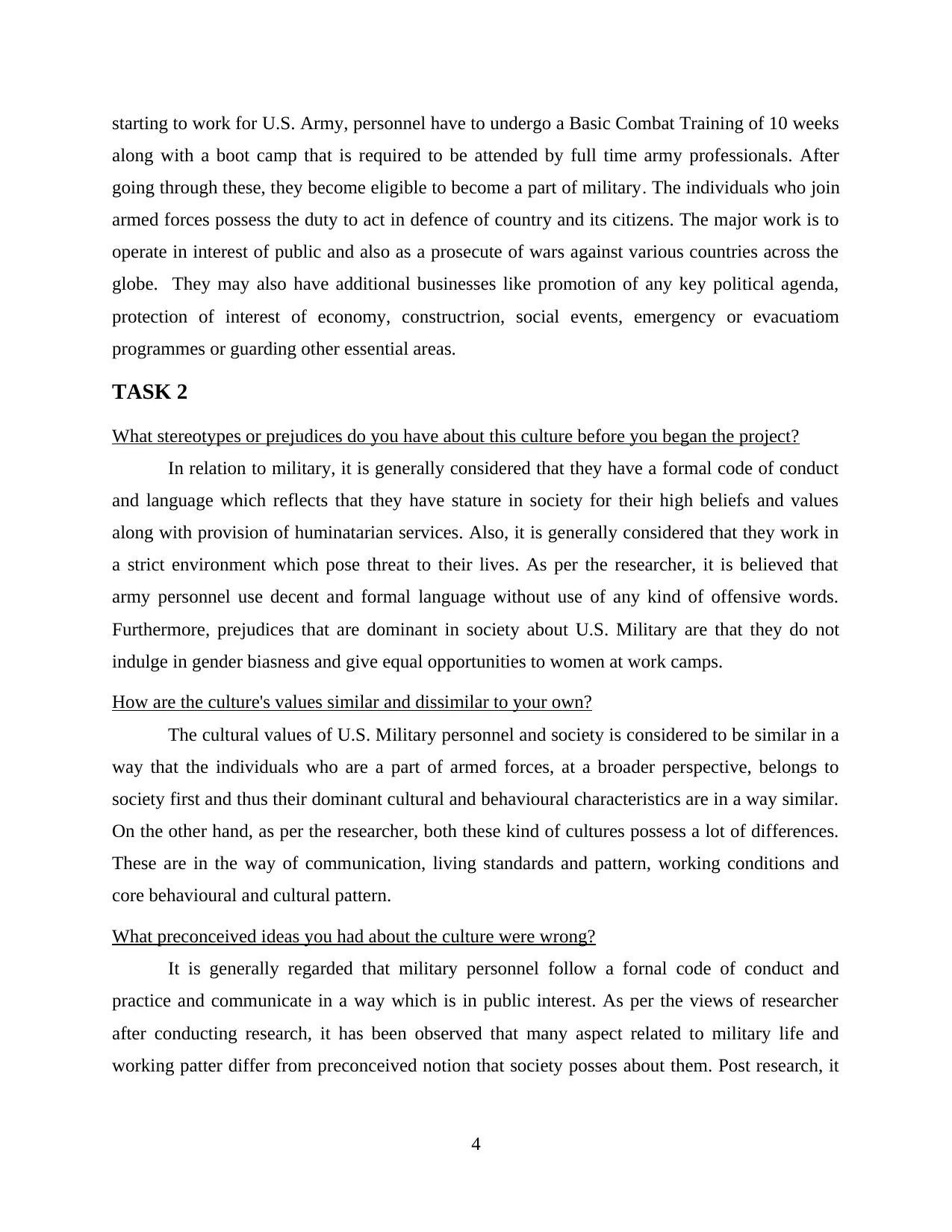
starting to work for U.S. Army, personnel have to undergo a Basic Combat Training of 10 weeks
along with a boot camp that is required to be attended by full time army professionals. After
going through these, they become eligible to become a part of military. The individuals who join
armed forces possess the duty to act in defence of country and its citizens. The major work is to
operate in interest of public and also as a prosecute of wars against various countries across the
globe. They may also have additional businesses like promotion of any key political agenda,
protection of interest of economy, constructrion, social events, emergency or evacuatiom
programmes or guarding other essential areas.
TASK 2
What stereotypes or prejudices do you have about this culture before you began the project?
In relation to military, it is generally considered that they have a formal code of conduct
and language which reflects that they have stature in society for their high beliefs and values
along with provision of huminatarian services. Also, it is generally considered that they work in
a strict environment which pose threat to their lives. As per the researcher, it is believed that
army personnel use decent and formal language without use of any kind of offensive words.
Furthermore, prejudices that are dominant in society about U.S. Military are that they do not
indulge in gender biasness and give equal opportunities to women at work camps.
How are the culture's values similar and dissimilar to your own?
The cultural values of U.S. Military personnel and society is considered to be similar in a
way that the individuals who are a part of armed forces, at a broader perspective, belongs to
society first and thus their dominant cultural and behavioural characteristics are in a way similar.
On the other hand, as per the researcher, both these kind of cultures possess a lot of differences.
These are in the way of communication, living standards and pattern, working conditions and
core behavioural and cultural pattern.
What preconceived ideas you had about the culture were wrong?
It is generally regarded that military personnel follow a fornal code of conduct and
practice and communicate in a way which is in public interest. As per the views of researcher
after conducting research, it has been observed that many aspect related to military life and
working patter differ from preconceived notion that society posses about them. Post research, it
4
along with a boot camp that is required to be attended by full time army professionals. After
going through these, they become eligible to become a part of military. The individuals who join
armed forces possess the duty to act in defence of country and its citizens. The major work is to
operate in interest of public and also as a prosecute of wars against various countries across the
globe. They may also have additional businesses like promotion of any key political agenda,
protection of interest of economy, constructrion, social events, emergency or evacuatiom
programmes or guarding other essential areas.
TASK 2
What stereotypes or prejudices do you have about this culture before you began the project?
In relation to military, it is generally considered that they have a formal code of conduct
and language which reflects that they have stature in society for their high beliefs and values
along with provision of huminatarian services. Also, it is generally considered that they work in
a strict environment which pose threat to their lives. As per the researcher, it is believed that
army personnel use decent and formal language without use of any kind of offensive words.
Furthermore, prejudices that are dominant in society about U.S. Military are that they do not
indulge in gender biasness and give equal opportunities to women at work camps.
How are the culture's values similar and dissimilar to your own?
The cultural values of U.S. Military personnel and society is considered to be similar in a
way that the individuals who are a part of armed forces, at a broader perspective, belongs to
society first and thus their dominant cultural and behavioural characteristics are in a way similar.
On the other hand, as per the researcher, both these kind of cultures possess a lot of differences.
These are in the way of communication, living standards and pattern, working conditions and
core behavioural and cultural pattern.
What preconceived ideas you had about the culture were wrong?
It is generally regarded that military personnel follow a fornal code of conduct and
practice and communicate in a way which is in public interest. As per the views of researcher
after conducting research, it has been observed that many aspect related to military life and
working patter differ from preconceived notion that society posses about them. Post research, it
4
⊘ This is a preview!⊘
Do you want full access?
Subscribe today to unlock all pages.

Trusted by 1+ million students worldwide
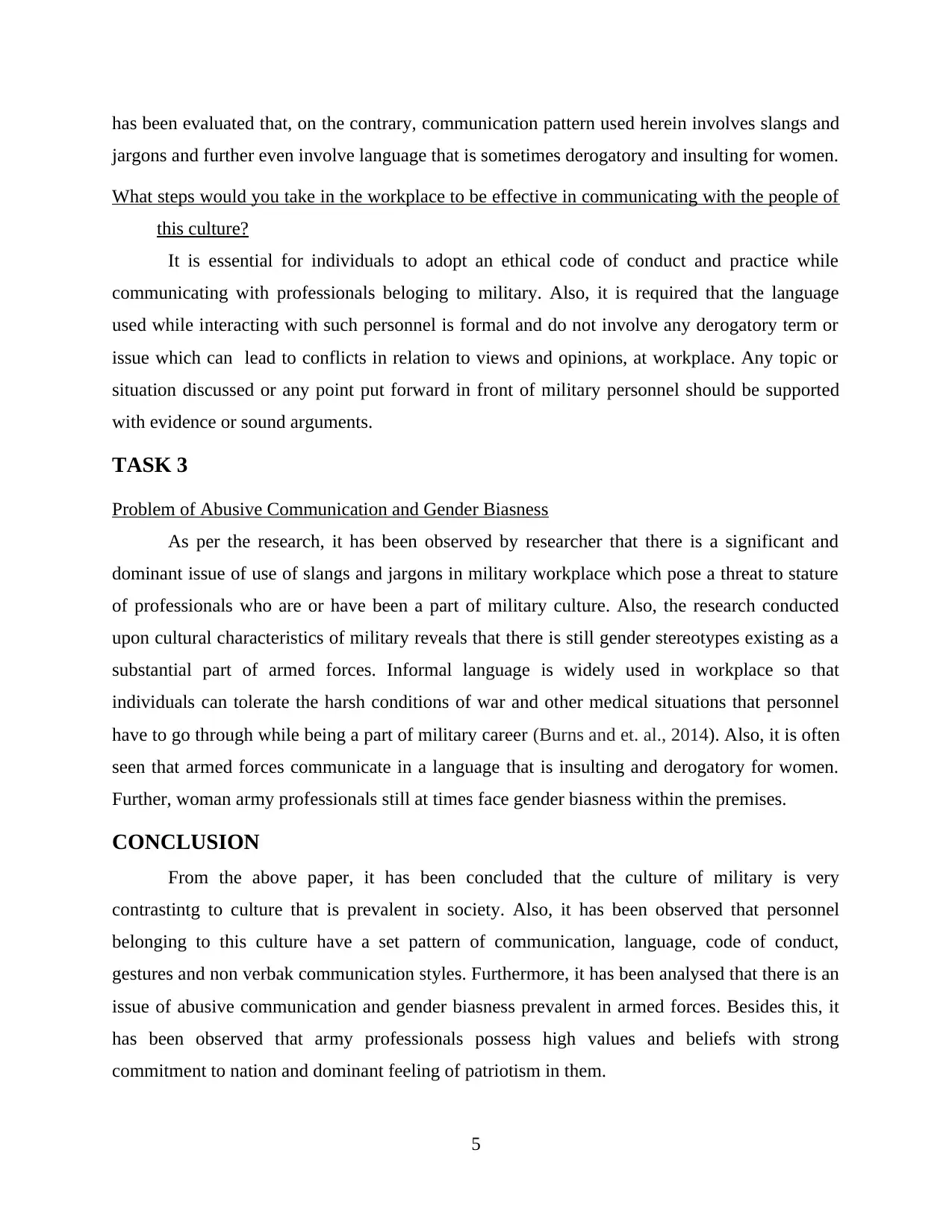
has been evaluated that, on the contrary, communication pattern used herein involves slangs and
jargons and further even involve language that is sometimes derogatory and insulting for women.
What steps would you take in the workplace to be effective in communicating with the people of
this culture?
It is essential for individuals to adopt an ethical code of conduct and practice while
communicating with professionals beloging to military. Also, it is required that the language
used while interacting with such personnel is formal and do not involve any derogatory term or
issue which can lead to conflicts in relation to views and opinions, at workplace. Any topic or
situation discussed or any point put forward in front of military personnel should be supported
with evidence or sound arguments.
TASK 3
Problem of Abusive Communication and Gender Biasness
As per the research, it has been observed by researcher that there is a significant and
dominant issue of use of slangs and jargons in military workplace which pose a threat to stature
of professionals who are or have been a part of military culture. Also, the research conducted
upon cultural characteristics of military reveals that there is still gender stereotypes existing as a
substantial part of armed forces. Informal language is widely used in workplace so that
individuals can tolerate the harsh conditions of war and other medical situations that personnel
have to go through while being a part of military career (Burns and et. al., 2014). Also, it is often
seen that armed forces communicate in a language that is insulting and derogatory for women.
Further, woman army professionals still at times face gender biasness within the premises.
CONCLUSION
From the above paper, it has been concluded that the culture of military is very
contrastintg to culture that is prevalent in society. Also, it has been observed that personnel
belonging to this culture have a set pattern of communication, language, code of conduct,
gestures and non verbak communication styles. Furthermore, it has been analysed that there is an
issue of abusive communication and gender biasness prevalent in armed forces. Besides this, it
has been observed that army professionals possess high values and beliefs with strong
commitment to nation and dominant feeling of patriotism in them.
5
jargons and further even involve language that is sometimes derogatory and insulting for women.
What steps would you take in the workplace to be effective in communicating with the people of
this culture?
It is essential for individuals to adopt an ethical code of conduct and practice while
communicating with professionals beloging to military. Also, it is required that the language
used while interacting with such personnel is formal and do not involve any derogatory term or
issue which can lead to conflicts in relation to views and opinions, at workplace. Any topic or
situation discussed or any point put forward in front of military personnel should be supported
with evidence or sound arguments.
TASK 3
Problem of Abusive Communication and Gender Biasness
As per the research, it has been observed by researcher that there is a significant and
dominant issue of use of slangs and jargons in military workplace which pose a threat to stature
of professionals who are or have been a part of military culture. Also, the research conducted
upon cultural characteristics of military reveals that there is still gender stereotypes existing as a
substantial part of armed forces. Informal language is widely used in workplace so that
individuals can tolerate the harsh conditions of war and other medical situations that personnel
have to go through while being a part of military career (Burns and et. al., 2014). Also, it is often
seen that armed forces communicate in a language that is insulting and derogatory for women.
Further, woman army professionals still at times face gender biasness within the premises.
CONCLUSION
From the above paper, it has been concluded that the culture of military is very
contrastintg to culture that is prevalent in society. Also, it has been observed that personnel
belonging to this culture have a set pattern of communication, language, code of conduct,
gestures and non verbak communication styles. Furthermore, it has been analysed that there is an
issue of abusive communication and gender biasness prevalent in armed forces. Besides this, it
has been observed that army professionals possess high values and beliefs with strong
commitment to nation and dominant feeling of patriotism in them.
5
Paraphrase This Document
Need a fresh take? Get an instant paraphrase of this document with our AI Paraphraser
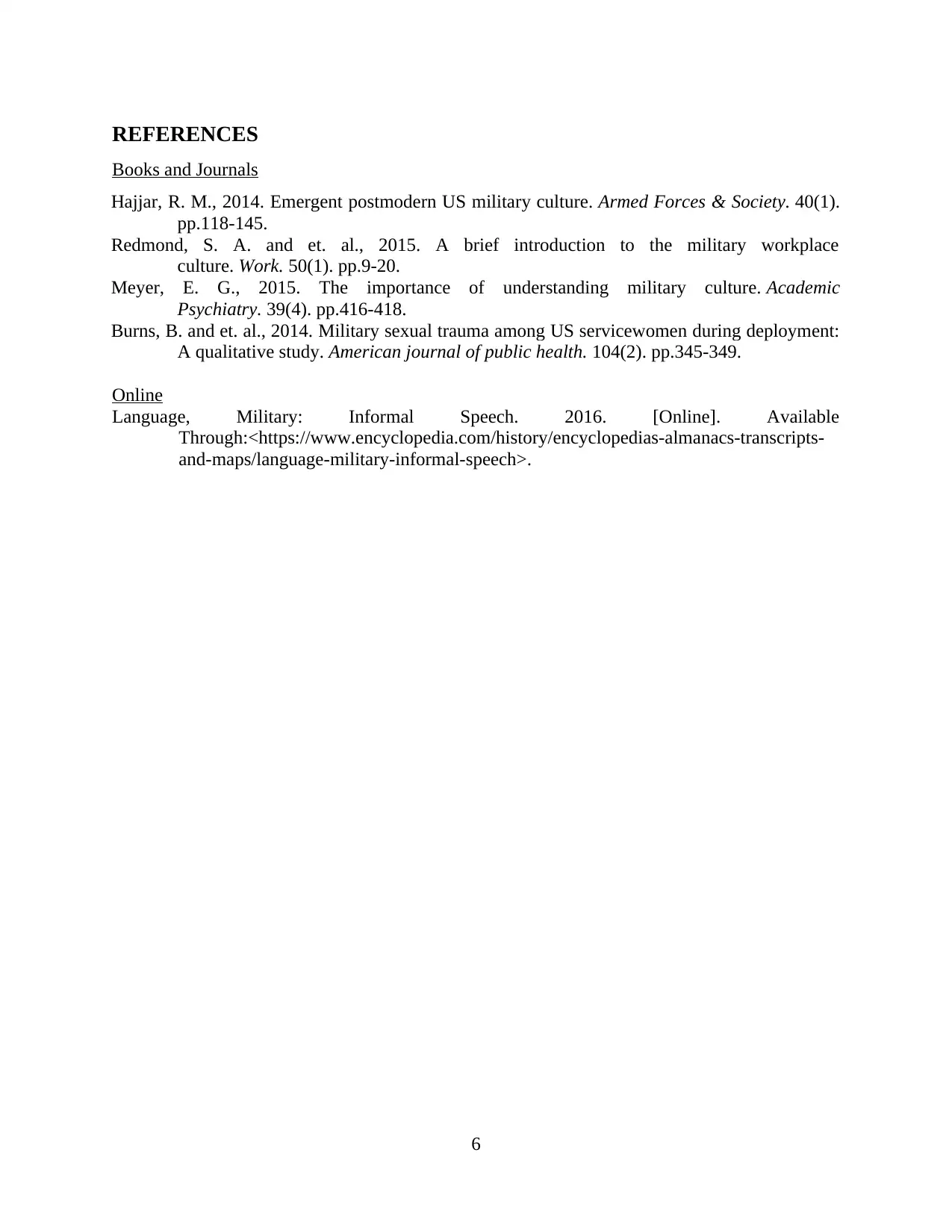
REFERENCES
Books and Journals
Hajjar, R. M., 2014. Emergent postmodern US military culture. Armed Forces & Society. 40(1).
pp.118-145.
Redmond, S. A. and et. al., 2015. A brief introduction to the military workplace
culture. Work. 50(1). pp.9-20.
Meyer, E. G., 2015. The importance of understanding military culture. Academic
Psychiatry. 39(4). pp.416-418.
Burns, B. and et. al., 2014. Military sexual trauma among US servicewomen during deployment:
A qualitative study. American journal of public health. 104(2). pp.345-349.
Online
Language, Military: Informal Speech. 2016. [Online]. Available
Through:<https://www.encyclopedia.com/history/encyclopedias-almanacs-transcripts-
and-maps/language-military-informal-speech>.
6
Books and Journals
Hajjar, R. M., 2014. Emergent postmodern US military culture. Armed Forces & Society. 40(1).
pp.118-145.
Redmond, S. A. and et. al., 2015. A brief introduction to the military workplace
culture. Work. 50(1). pp.9-20.
Meyer, E. G., 2015. The importance of understanding military culture. Academic
Psychiatry. 39(4). pp.416-418.
Burns, B. and et. al., 2014. Military sexual trauma among US servicewomen during deployment:
A qualitative study. American journal of public health. 104(2). pp.345-349.
Online
Language, Military: Informal Speech. 2016. [Online]. Available
Through:<https://www.encyclopedia.com/history/encyclopedias-almanacs-transcripts-
and-maps/language-military-informal-speech>.
6
1 out of 8
Related Documents
Your All-in-One AI-Powered Toolkit for Academic Success.
+13062052269
info@desklib.com
Available 24*7 on WhatsApp / Email
![[object Object]](/_next/static/media/star-bottom.7253800d.svg)
Unlock your academic potential
Copyright © 2020–2025 A2Z Services. All Rights Reserved. Developed and managed by ZUCOL.




